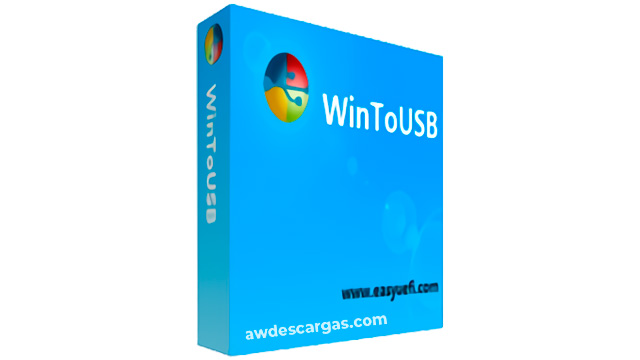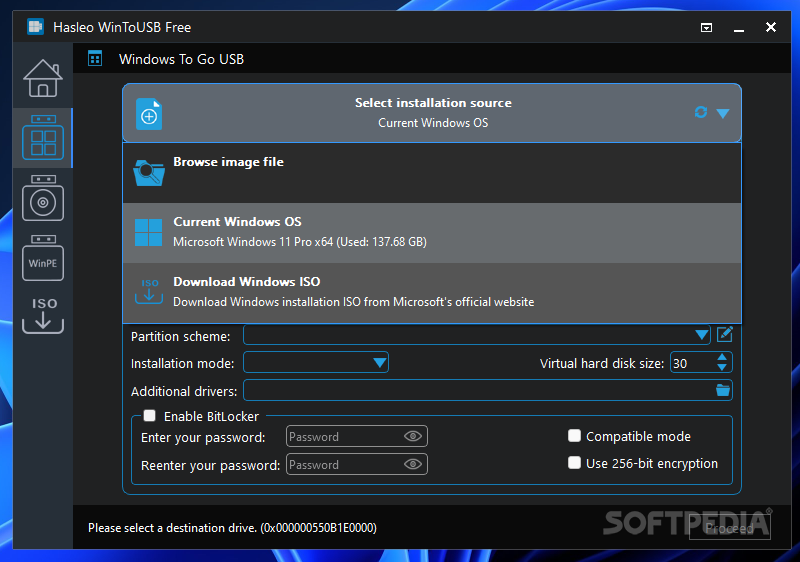
Type the following commands, excluding the ‘ ‘ around the commands (partially acquired from here):
#Wintousb mac install#
The objective here is to setup the USB 3 drive that you intend to install Windows on so that it will have an EFI partition, the Windows required reserved partition, and free disk space for the install. At the startup screen, run the command prompt by hitting Shift+F10.
#Wintousb mac Pc#
Option 2: If you created a bootable USB install drive with Boot Camp and want to use that instead of the Windows PC or virtual machine, boot the Boot Camp created Windows install USB drive by holding Option at reboot of your Mac and selecting the USB drive (called EFI Boot).
#Wintousb mac software#
This is all you will use Boot Camp to do.įor the Boot Camp options, leave the box checked that says “Download the latest Windows support software from Apple.” Uncheck “Install Windows 7 or later version.” Do not leave anything important on them.įor best results, use Boot Camp utility to create your thumb drive with Mac drivers. Your USB thumb drive and target drive for Windows will be erased during this process. This isn’t documented anywhere online that I could find, so I decided to put it out there for others to use.Īccess to a PC or virtual machine running Windows for the use of WinToUSB and the Command Prompt (as of the writing of this How–To, this is the easiest and fastest way to do this.)Ī USB 3.0/3.1 drive (recommended over 2.0 for speed, and can have other I/O options like Thunderbolt, but USB is necessary for the WinToUSB software).
#Wintousb mac iso#
All you need to do is install the Boot Camp app, let the assistant load, show the location of the ISO image, and let it roll from there.I put several peoples ideas together from various tech workarounds to make this possible. However, older Mac computers can still use it. Apple has banned the use of it on newer macOS devices, which means you might not even be able to use it. This method is the one we recommend the least. You won’t have to worry about splitting the file, as the app does it for you. When ready, just burn the image onto the drive.

Before you can use it, you need to import Windows 11 ISO image and insert the USB. Once you open the application, there’s a Burn function you’ll need to activate.

Also, you’ll need a USB drive with at least 16 GB storage space and the Windows 11 ISO image.įrom here, start by downloading and installing WonderISO. There are some requirements you’ll need to meet, such as having macOS version 10.12, 11 on your device. One of the top tools that takes most of the hassle of making a Windows 11 bootable USB drive on a Mac easier for you is WonderISO. You now need to copy the Windows ISO image, but make sure it doesn’t include the file “install.wim”. Your input starts with hdiutil mount and then the ISO folder location. Now, you will need to mount the specific Windows ISO folder that should be in the Downloads section of your Mac. Make a note on your phone or a piece of paper which disk number refers to the USB. Enter the text ‘diskutil list’, which will reveal all the drives on your computer. Also, since your Windows 11 ISO image will be above 4 GB, you’ll have to split the “install.wim” file.įirst, place the drive in your Mac device and open Terminal. Before you proceed, you need to ensure that you have Homebrew as well as wimlab on your macOS device. Here’s one of the easiest ways to make a Windows 11 bootable USB on a macOS device.


Make a Windows 11 bootable USB on Mac with Terminal By making a Windows 11 Bootable USB on Mac, you can quickly resurrect your laptop or PC in minutes. It means saving you a trip and money on having it repaired by someone else.


 0 kommentar(er)
0 kommentar(er)
